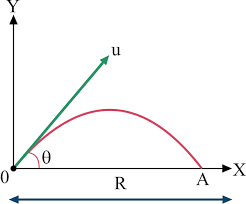
Answer
110.4k+ views
Hint: The range of the projectile is the max horizontal distance covered by the projectile. This is calculated using the expression relating the projectile velocity, acceleration due to gravity and angle of projection. Substitute the values in S.I units to find the range.
Complete step-by-step answer
For a projectile motion the horizontal distance traveled by a body during the time of flight is range. Assuming that the staring and the end point are at equal height, the range of the projectile (R) is given by

$R = \dfrac{{{u^2}\sin 2\theta }}{g}$
Where,
u is the velocity of the object
θ is the angle of projection
g is the acceleration due to gravity
The data given in the problem:
\[\begin{array}{*{20}{l}}
{u{\text{ }} = {\text{ }}9.8{\text{ }}m{s^{ - 1}}} \\
{g{\text{ }} = {\text{ }}9.8{\text{ }}m{s^{ - 2}}} \\
{\theta = {\text{ }}{{45}^0}}
\end{array}\]
Now substitute the known data in the range formula
$
R = \dfrac{{{{9.8}^2} \times \sin 90}}{{9.8}} \\
R = 9.8m \\
$
Hence, the range of the projectile is 9.8 m and the correct option is B
Note
1. Range of the projectile is max when it is projected with an angle of 45o.
Range of the projectile can also be expressed as
$R = \dfrac{{2{u_x}{u_y}}}{g}$
Where, $u_x$ and $u_y$ are the components of initial velocity.
2. In a general case: the starting and the end point of the projectile need not be at the same height.

Then this formula can be used
$R = \dfrac{{{v^2}}}{{2g}}\left( {1 + \sqrt {1 + \dfrac{{2gy}}{{2{{\sin }^2}\theta }}} } \right)$
Here R is the range, v is the launching velocity, g is the acceleration due to gravity, y is the difference in height between the starting and ending point from the ground, $\theta $ is the initial angle of launch
Complete step-by-step answer
For a projectile motion the horizontal distance traveled by a body during the time of flight is range. Assuming that the staring and the end point are at equal height, the range of the projectile (R) is given by

$R = \dfrac{{{u^2}\sin 2\theta }}{g}$
Where,
u is the velocity of the object
θ is the angle of projection
g is the acceleration due to gravity
The data given in the problem:
\[\begin{array}{*{20}{l}}
{u{\text{ }} = {\text{ }}9.8{\text{ }}m{s^{ - 1}}} \\
{g{\text{ }} = {\text{ }}9.8{\text{ }}m{s^{ - 2}}} \\
{\theta = {\text{ }}{{45}^0}}
\end{array}\]
Now substitute the known data in the range formula
$
R = \dfrac{{{{9.8}^2} \times \sin 90}}{{9.8}} \\
R = 9.8m \\
$
Hence, the range of the projectile is 9.8 m and the correct option is B
Note
1. Range of the projectile is max when it is projected with an angle of 45o.
Range of the projectile can also be expressed as
$R = \dfrac{{2{u_x}{u_y}}}{g}$
Where, $u_x$ and $u_y$ are the components of initial velocity.
2. In a general case: the starting and the end point of the projectile need not be at the same height.

Then this formula can be used
$R = \dfrac{{{v^2}}}{{2g}}\left( {1 + \sqrt {1 + \dfrac{{2gy}}{{2{{\sin }^2}\theta }}} } \right)$
Here R is the range, v is the launching velocity, g is the acceleration due to gravity, y is the difference in height between the starting and ending point from the ground, $\theta $ is the initial angle of launch
Recently Updated Pages
Write an article on the need and importance of sports class 10 english JEE_Main

Write a composition in approximately 450 500 words class 10 english JEE_Main

Arrange the sentences P Q R between S1 and S5 such class 10 english JEE_Main

If x2 hx 21 0x2 3hx + 35 0h 0 has a common root then class 10 maths JEE_Main

The radius of a sector is 12 cm and the angle is 120circ class 10 maths JEE_Main

For what value of x function fleft x right x4 4x3 + class 10 maths JEE_Main

Other Pages
Excluding stoppages the speed of a bus is 54 kmph and class 11 maths JEE_Main

Electric field due to uniformly charged sphere class 12 physics JEE_Main

The energy stored is a condenser is in the form of class 12 physics JEE_Main

If a wire of resistance R is stretched to double of class 12 physics JEE_Main

In Searles apparatus when the experimental wire is class 11 physics JEE_Main




